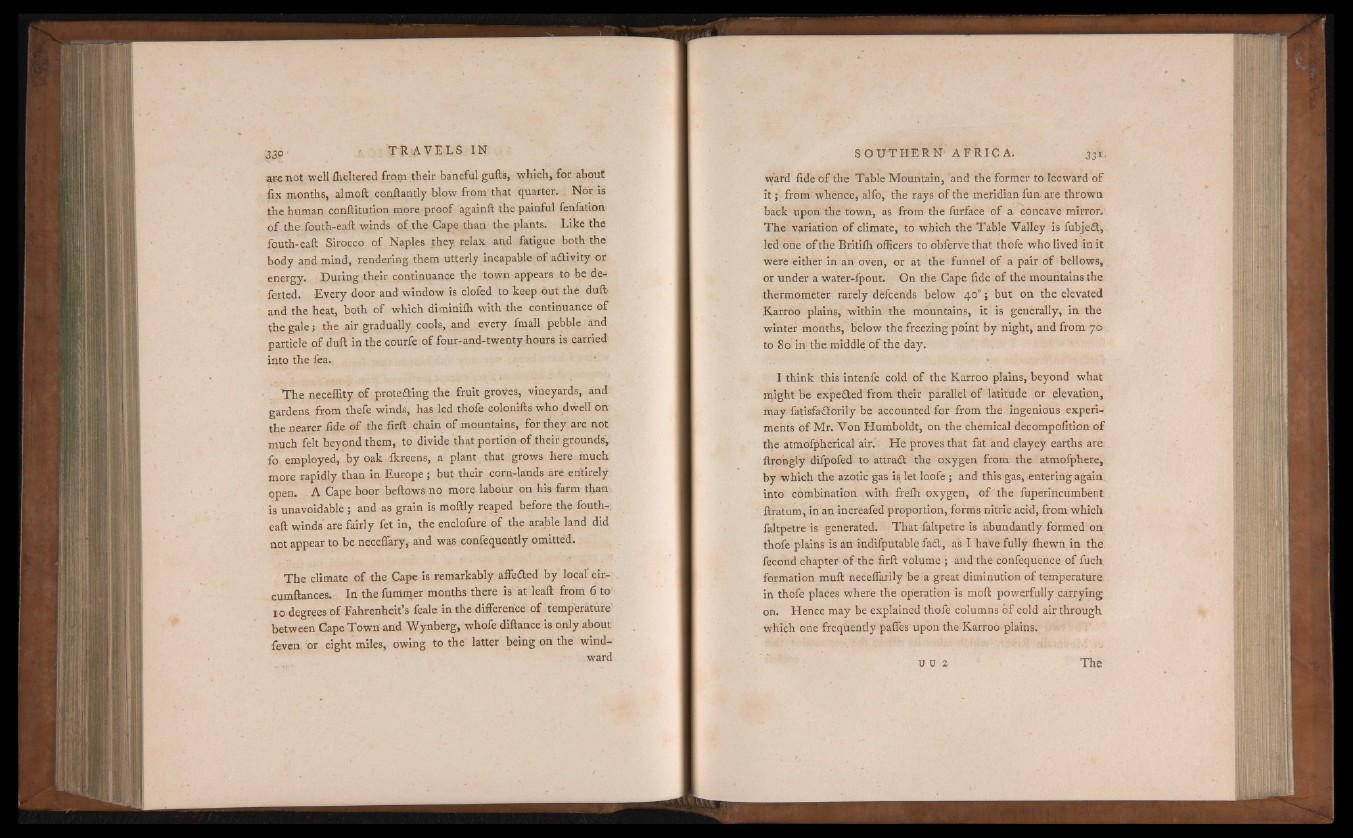
are not well iheltered from their baneful gufts, which, for about
fix months, almoft conflantly blow from that quarter. Nor is
the human conftitutipn more proof againft the painful fenfation
of the fouth-eaft winds of the Cape than the plants; Like the
fouth-eaft Sirocco of Naples they relax and fatigue both the
body and mind, rendering them utterly incapable of adivity or
energy. During,their continuance the town appears to be de-
ferted. Every door and window is clofed to keep out the duffc
and the heat, both of which diminifh with the continuance of
the gale j the air gradually cools, and every, fmall pebble and
particle of duft in the courfe of four-and-twenty hours is carried
into the fea.
The necefiity of proteding the fruit groves, vineyards, ánd
gardens, from thefe winds, has led thofe colonifts who dwell on
the nearer fide of the firft chain of mountains, for they are not
much felt beyond them, to divide that portion of their grounds,
fo employed, by oak Ikreens, a plant that grows here much
more rapidly than in Europe; but their corn-lands aré entirely
open. A Cape boor bellows no more labour on his farm than
is unavoidable ; and as grain is moftly reaped before the fouth-
eaft winds' are fairly fet in, the enclofure of the arable land did
not appear to be neceffary, and was confequeñtly omitted.
The climate of the Cape is remarkably affeded by local cir-
cumftances. In the fummer months there is at leáft from 6 to
I o degrees of Fahrenheit’s fcale in the difference of temperature
between Cape Town and Wynberg, whofe diftance is only about
feven or eight miles, owing to the latter being on the windward
ward fide of the Table Mountain, and the former to leeward of
i t ; from whence, alfo, the rays of the meridian fun. are thrown
back upon the town, as from the furface of a concave mirror.
The variation of climate, to which the Table Valley is fubjed,
led one of the Britilh officers to obferve that thofe who lived in it
were either in an oven, or at the funnel of a pair of bellows,
or under a water-fpout. On the Cape fide of the mountains the
thermometer rarely defcends below 40°; but on the elevated
Karroo plains, within the mountains, it is generally, in the
winter months, below the freezing point by night, and from 70
to 80 in the middle of the day.
I think this intenfe cold of the Karroo plains, beyond what
might be expeded from their parallel of latitude or elevation.,
may fatisfadorily be accounted for from the ingenious experiments
of Mr. Von Humboldt, on the chemical decompofition of
the atmofpherical air. He proves that fat and clayey earths are
llrongly difpofed to attrad the oxygen from the atmofphere,
by which the azotic gas is, let loofe ; and this gas, entering again
into combination with freih oxygen, of the fuperincumbent
ftratum, in an increafed proportion, forms nitric acid, from which
faltpetre is generated. That faltpetre is abundantly formed on
thofe plains is an indifputable fad, as I have fully Ihewn in the
fecond chapter of the firft volume ; and the confequence of fuch
formation muft neceffarily be a great diminution of temperature
in thofe places where the operation is mod powerfully carrying
on. Hence may be explained thofe columns of cold air through
which one frequently paffes upon the Karroo plains.